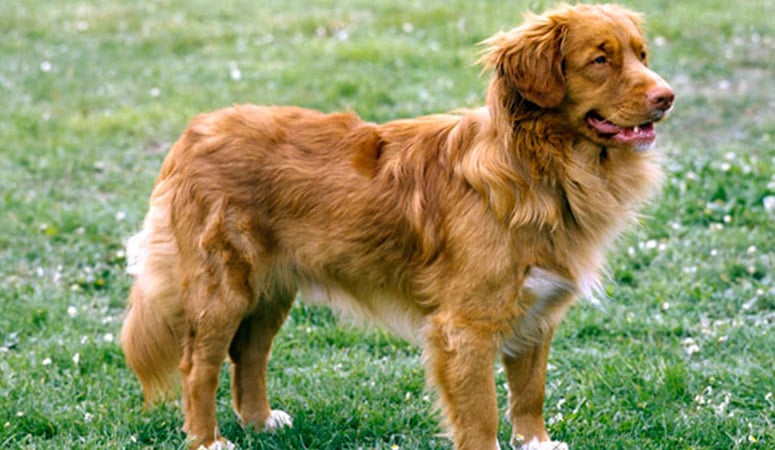Nova Scotia Duck Tolling Retriever

As the smallest of the retrievers and eager, affectionate gundog, the Nova Scotia Duck Tolling Retriever is curious, playful, and intelligent. With high energy, this sporting breed enjoys hunting, hiking, and playing. As lovable and rambunctious companions, they do well in dog-experienced families. Hard to find this breed today, it’s important to make sure the energy level and temperament are suitable for the household.
| Other Names | Little River Duck Dog, YarMouth Toller |
| Color | Red, Red Gold, White Markings |
| Height | Males: 18-21 inches. Females: 17-20 inches. |
| Weight | Males: 44-51 pounds. Females: 37-44 pounds. |
| Life Span | 12-14 years |
| Personality | Affectionate, Intelligent, Outgoing |
| Exercise | Needs Lots of Activity |
| Origin |
| Popularity | #86 |
| Groom Needs | Weekly Brushing |
| Kids Friendly | Yes |
| Dog Friendly | Yes with supervision |
| Watch Dog | |
| Family Dog | |
| Litter Size | 6–10 pups |
Nova Scotia Duck Tolling Retriever Pictures
Nova Scotia Duck Tolling Retriever Video
Introduction
The American Kennel Club grouped this breed under the Sporting Group. A Nova Scotia Duck Tolling Retriever is a vibrant, agile, and athletic dog, of medium size. It is probably the smallest terrier dog breed in America. With an almond-shaped eye and feathery tail, it gives a fair representation of a wolf. They are affectionate and highly intelligent. The hallmarks of the Toller (for short) are the medium-length coat (with a dense undercoat), and medium-sized body, easily mistaken for a Golden Retriever. They come in shades of crimson, red, or orange color. Tollers might even be a curious blend of stubborn and willing to please.
Being medium-sized dogs, a male Toller measures around 18-22 inches from shoulder to paw, when it stands. The females run just a bit smaller, at a height of around 17-20 inches. They weigh around 30-50 pounds. The average Toller is a compact and handsome dog. Relatively, the Toller is a healthy breed and has a life expectancy of 11-14 years on the average. It is ranked the 83rd most popular dog breed in America.
Living with Nova Scotia Duck Tolling Retriever
As a wash-and-go dog, Tollers’ coat requires only weekly brushing to remove dead hair and keep the fur from matting throughout most of the year. But daily brushing may be necessary during the spring and fall shedding seasons.
During the puppyhood, about at three to four months of age, the Toller’s ears may go wonky, folding back instead of framing the face. The ears may need to be taped to regain the correct position with the help of a professional breeder.
You should pay special attention to the coat around and under the ears and feet to remove excess hair, where the coat is finer and more likely to knot. This minimal grooming can help the Toller keep traction on indoor surfaces.
Trim the nails every week, clean and trim the foot pads, and pluck around the ears if they’re particularly hairy. Full and bushy, the tail should never be trimmed and sculpted.
Brush your Toller’s teeth at least two or three times a week to remove tartar buildup and the bacteria that lurk inside it. Daily brushing can help to prevent gum disease and bad breath better.
Start to groom at an early age and make it a positive experience filled with praise and rewards, and you’ll find it easy to do the groundwork, such as veterinary exams and other handling when he’s an adult.
As active breed, especially excelling in playing and retrieving, Tollers need lots of exercise to keep fit. Without proper exercise and activity, a Toller may become destructive or prone to nuisance barking. At least an hour’s worth of extensive playtime and a few brisk walks or jogs through the neighborhood are necessary.
A fenced yard or outdoor space is necessary for the Toller to romp and run.
As excellent playmates for their kids, the Toller is happy to play ball or fetch for hours, keeping both the dog and the kids active. Besides, he’ll enjoy a couple of 30-minute walks or runs, a hike of an hour or two, or any other combination of exercise that you can do together.
They love water. Swimming is another activity loved by Nova Scotia Duck Tolling Retrievers and water play and retrieving can help keep the Toller in tiptop shape.
They should not be allowed to jump up or off furniture, or run up and down the stairs, because giving too much exercise will increase pressure on their joints and bones, which are still growing, leading to a few problems later on in their lives.
They’re not well-suited to live outdoors full-time because they prefer the company of family. If left outdoors alone, they may bark excessively or disappear in search of something interesting to do.
Tollers need high-quality dog food whether commercially manufactured or home-prepared with your veterinarian’s supervision and approval every day to meet its nutrition needs and keep fit.
The amount of dog food should be split between two meals and vary with dog’s size, age, activity level and metabolism. You can change a puppy’s diet, which should be done gradually to making sure they don’t develop any digestive upsets.
Tollers do not tend to guard their food, but children should never be allowed to touch or remove food while any dog is eating.
Treats can be an important aid in training, but giving too many can lead to obesity. So watch your dog’s calorie consumption and weight level to keep it from getting overweight.
Clean, fresh water should be available at all times.
Learn about which human foods are safe for dogs, and which are not. Check with your vet if you have any concerns about your dog’s weight or diet.
Tollers are generally healthy, but like all breeds, they may develop different health problems, such as hip and elbow dysplasia, deafness, eye concerns, addison’s disease and cleft palate. So it’s important to be aware of them if you’re considering this breed.
Tollers also are somewhat more prone than other breeds to develop autoimmune-related issues. Efforts to develop a gene-marker test have been unsuccessful so far.
A good breeder should be honest and care about their dogs and tell the exact symptoms of the dog and the incidence with which they occur in her lines to prevent some serious diseases.
Responsible breeders should take their dogs to check with the vet to prevent some diseases by some health tests recommended by the National Breed Club, including hip evaluation, ophthalmologist evaluation, PRA optigen DNA test, cardiac exam and juvenile addison’s disease (JADD) DNA Test.
Total Annual Cost: $3177.9
Cost is estimated for the first year and may vary depending on many factors, such as dog food, health care, leash, collar, licensing, possible fencing, crates, training and obedience classes, dog-walking, grooming, treats, toys, flea, tick, and heart-worm meds, microchips, etc.
Born yipping and running around, Toller puppies are highly active, but eventually their activity level tapers to a more manageable level. With the brain of a Chessie and the heart of a spaniel, these characters make them challenging to train.
Tollers were developed as gundogs who could both lure and retrieve, so this breed is an ideal companion for waterfowl hunting. And they are good candidates for search and rescue and nosework.
Basic training won’t be enough to challenge the Toller—they want to exercise body and mind. Early socialization and teaching basic manners with a variety of people are ideal for a well-behaved adult Toller. Advanced tricks, agility, flyball, and dock diving are all good ways for a Duck Toller to burn energy and put their sharp mind to use.
For this breed, you won’t want to get into a battle of wills with it because you’ll lose. Instead, you should be patient and gentle with your Toller, set firm rules, enforce them consistently, and don’t let your Toller get bored.
They are ready to learn—but aren’t always willing to comply with your requests. To gain his trust and respect, there should be no anger, intimidation, or physical force during training. When he’s motivated by praise, play, and food rewards, the Toller learns quickly and easily.
Tollers can be destructive as puppies without proper supervision and the adults can be destructive as well if they don’t get the exercise they need. Crate training will help a lot.
History
Not much is known about the history of the Toller, the small dog with a big name. The Nova Scotia Duck Tolling Retriever, also called the Yarmouth Toller, was bred by local breeders and sportsmen in the Acadian community of the Little River Harbor, in Yarmouth County, Nova Scotia in Canada. They are believed to have developed around the early part of the 19th century from a series of crosses which, perhaps, involved several retrievers, setters, and spaniels. The Toller is likened to the Dutch Decoy Spaniel — the Kooikerhondje — in that they were both gun-dogs specialized at retrieving waterfowls after they must have lured them into shot range. The Toller was a favorite hunters’ dog, at the shore, this dog makes rustling movements or fetches to attract ducks out of the water into the shorelines while the hunter kept out of sight. When the target is dab in view, the hunter downs it, and the Toller retrieves the meat.
Modern Tollers are equal to the task and have developed into several other roles. The Canadian Kennel Club recognized this breed as a distinct breed in 1945. The Nova Scotia Duck Tolling Retriever became the longest breed name recorded in the AKC Studbook when it was recognized in 2003. The Toller breed might as soon be a well-recognized breed in many parts of the world.
Helpful Information
Breed Club: NOVA SCOTIA DUCK TOLLING RETRIEVER CLUB (USA)
Breed Club Link: http://nsdtrc-usa.org/
Breed Club Rescue: NSDTRC (USA) Rescue Program
Breed Club Rescue Link: http://nsdtrc-usa.org/about/rescue/




